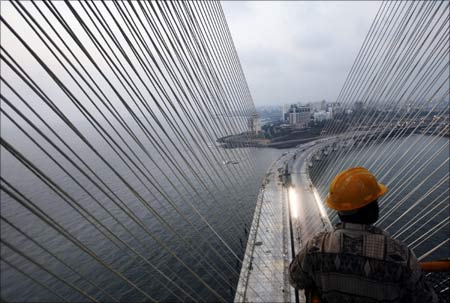
Liquidity-starved sectors such as infrastructure and realty could be the biggest beneficiaries of the vote of confidence for the UPA.
A clear mandate for the United Progressive Alliance and the continuity of the current government's policies are likely to keep the markets buoyant for a while.
Marketmen believe that foreign institutional investors and domestic institutions, which were not participating aggressively in the markets thus far, are likely to invest for the long term, given the stable government at the Centre.
Opening up of the economy, allowing foreign direct investment and easier interest rates should improve liquidity and are expected to help sectors such as infrastructure, banking, real estate, telecom, power, education and retail.
Text: Jitendra Kumar Gupta & Sarath Chelluri

With the Left crutch that crippled decision-making now out of the way, the new government is likely to speed up the divestment of its stake in various PSUs. While experts believe that the markets could touch the 16,000 mark, stiff valuations and the burgeoning fiscal deficit could cap the upsides.
Analysts said sectors such as telecom could also see action if the government speeds up the 3G auction process, merges MTNL with BSNL and lists the new entity, and divests its 26 per cent stake in Tata Communications.
FMCG and pharma sectors, which are considered defensive, are likely to underperform as the market chases growth. IT services, which is another defensive sector, is unlikely to participate in the rally given that the rupee is expected to gain in the short term.

Banking
Analysts are not ruling out a possibility of an increase in the non-performing assets of the public sector banks, going ahead.
Further, the Congress manifesto adds that it will strive to provide interest subsidy for agriculture, small and medium industries and education sectors. Thus, the government's dependence on the banking sector may be sustained in the future as well.
With the government borrowing programme at around Rs 3.6 lakh crore (Rs 3.6 trillion) in the first half of the year, bond yields are likely to stiffen and curtail treasury profits (mainly for PSU banks).
On the positive side, with the Left out of the picture, the government may open up the banking sector to foreign players and consolidate PSU banks.
For example, SBI has already merged one of its associate with itself and the government might consolidate other SBI associates with the parent.
Any moves to increase FDI limit in insurance from 26 per cent to 49 per cent will help financial institutions like ICICI Bank and HDFC to raise additional capital. Increased voting rights of foreign banks, which have more than 10 per cent stake in Indian banks, will bring the stocks of private banks into play.

Infrastructure
Most analysts believe that the market will give a thumbs up to infrastructure stocks as the Congress manifesto lists economic revival and restoring high growth as its immediate priority.
It also mentions that public expenditure on agriculture and infrastructure will be stepped up. The continuation of policies in the infrastructure space and expected increase in the liquidity should augur well for the sector.
Considering the Congress party's focus on the rural sector, investors need to look at companies in the rural infrastructure space such as IVRCL, Nagarjuna Construction and HCC.
Analysts believe that companies will now find it relatively easy to raise funds given the increasing confidence of the investors and flow of money from the FIIs and through the FDI route.
The decision-making process on projects related to infrastructure is likely to be expedited helping companies in this sector. Renewed buying is likely in infra stocks as valuations were beaten down due to growth concerns and credit crunch.

Real Estate
Improvement in the liquidity situation could be the biggest positive for this sector Analysts are expecting stability at the Centre and continuation of policies will attract more money from foreign investors.
Realty majors will now be able to raise funds through Qualified Institutional Placements or debt or through further equity issues. India's largest realty companies--DLF and Unitech--have already raised over a billion dollars in the recent past and chances are that others might follow.
Nirmal Jain, chairman, India Infoline, said "indications are that formation of a stable government will trigger flow of foreign capital in equity as well as debt. This would mean appreciation of the rupee and revival of liquidity-starved sectors such as real estate."
Analysts now believe that since the UPA can form the government without the support of the Left parties who were opposed to the idea of foreign direct investment, special economic zone projects, which were stalled, could get a fresh lease of life.